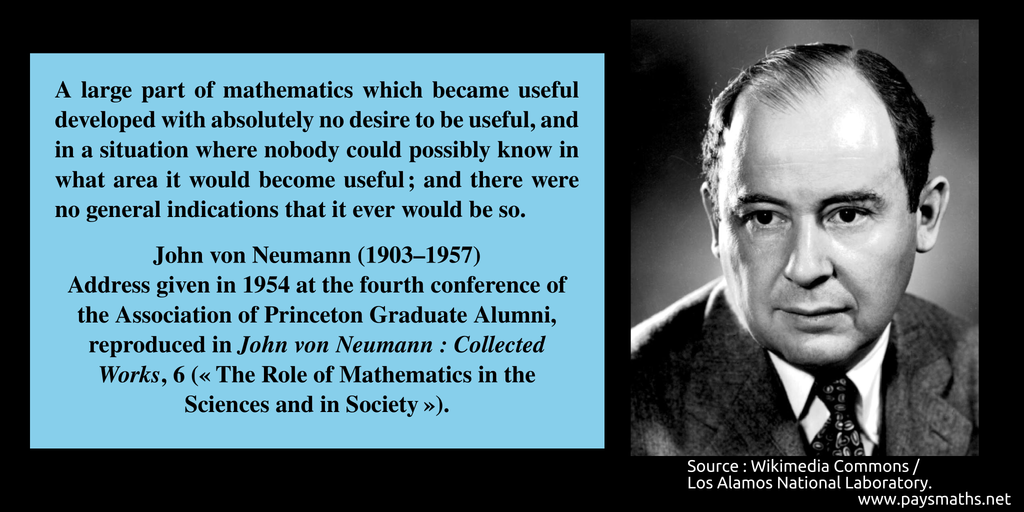Perfect description of the current corruption of Supreme Court. It is no longer a court, just an edict-issuing body. https://talkingpointsmemo.com/edblog/the-latest-defenses-of-scotuss-corruption-only-make-the-case-against-it
"A large part of mathematics which became useful developed with absolutely no desire to be useful, and in a situation where nobody could possibly know in what area it would become useful; and there were no general indications that it ever would be so." – John von Neumann (1903–1957)
#quote #mathematics #maths #math
"A large part of mathematics which became useful developed with absolutely no desire to be useful, and in a situation where nobody could possibly know in what area it would become useful; and there were no general indications that it ever would be so." – John von Neumann (1903–1957)
#quote #mathematics #maths #math
Some Junk Theorems in Lean
https://github.com/James-Hanson/junk-theorems-in-lean
#HackerNews #Some #Junk #Theorems #in #Lean #programming #Lean #Theorems #Junk #Theorems #Math #Community
#introduction I am new here. My brother @jaforbes tells me it is customary to do an opening post of things I find interesting or likely to discuss in the future. Here is my list: #democracy #ai #eng #engineering #osint #geopol #math #mathematics #humanrights #compsci #history #philosophy #space #australia #japan #bluemountains #science #tech #anu #unsw #uts #physics #uai #agi #nafo #peace #ukraine #taiwan #photography #tdd #andor. I have friends everywhere. I hope that you'll join me.
#introduction I am new here. My brother @jaforbes tells me it is customary to do an opening post of things I find interesting or likely to discuss in the future. Here is my list: #democracy #ai #eng #engineering #osint #geopol #math #mathematics #humanrights #compsci #history #philosophy #space #australia #japan #bluemountains #science #tech #anu #unsw #uts #physics #uai #agi #nafo #peace #ukraine #taiwan #photography #tdd #andor. I have friends everywhere. I hope that you'll join me.
Lewis Carroll Computed Determinants
https://www.johndcook.com/blog/2023/07/10/lewis-carroll-determinants/
#HackerNews #LewisCarroll #Determinants #Math #History #Computation #HackerNews
“Mathematics was another world I could explore. A world that was not confining, a world I could access at any point just by thinking about it."
-- Hannah Cairo
“Mathematics was another world I could explore. A world that was not confining, a world I could access at any point just by thinking about it."
-- Hannah Cairo
Advent of Tilings - Day 23.1
Almost at the end we see the light through diamond and hexagon shaped tunnels of an infinite surface, again monohedrally tiled.
#math #geometry #3d #combinatorics #tiling #AdventOfTilings #TilingTuesday
Advent of Tilings - Day 18.2
After applying “growth strategy 1” 20 times, adding 20 layers we end up with 22173 tiles.
The number of tiles in the added layers for the first ten steps:
1 + 6 + 20 + 53 + 98 + 161 + 246 + 352 + 474 + 615 + 762 + …
The Duodecimal Bulletin, Vol. 55, No. 1, Year 1209 [pdf]
https://dozenal.org/drupal/sites_bck/default/files/DuodecimalBulletinIssue551.pdf
#HackerNews #Duodecimal #Bulletin #Vol55 #Year1209 #pdf #Dozenal #Math #History
Advent of Tilings - Day 23.1
Almost at the end we see the light through diamond and hexagon shaped tunnels of an infinite surface, again monohedrally tiled.
#math #geometry #3d #combinatorics #tiling #AdventOfTilings #TilingTuesday
Advent of Tilings - Day 22.2
It takes only one rule to get from single tile to cuboid
f₁f₂t₁t₂⁻¹t₁f₁t₁⁻¹
Advent of Tilings - Day 22.1
It is not always easy to find a symmetric tree, but keep it in a pot and you may be surprised by what it grows up to be.
Advent of Tilings - Day 21.2
The looping rules seem to reflect the strictness of the construction:
(f₂t₁t₂)²
(f₁t₁t₁)²
Advent of Tilings - Day 21.1
This tiling grows following a double pyramid shape that would make Djoser proud. Embeddable and monohedral.
Advent of Tilings - Day 20.2
The twist of the structure is accomplished by the rules:
(f₁t₁)² and f₁f₂t₂⁻¹t₁t₂t₂f₂t₂⁻¹ and (f₁f₂t₂⁻¹)³
I was thinking about ways to visualize just how insanely much money a billionaire owns. What I came up with now is using length: let's say 1,000€ is 1 millimeter. Each millimeter counts.
So most people go through their daily lives with a finger's width or less (1 centimeter is 10,000€). Even people you might consider very well off might "just" have a hand's width available (10 centimeters is 100,000€). Now, some people are called millionaires and they have more than a whole freaking meter! Visualize this and compare with the hand's width and finger's width. Okay...I guess?
But then there's billionaires. I find it disgusting to think about how excessively much money for a single person this is. They have more than a kilometer!! Visualize and let it sink in. Look out the window and think about how long a kilometer is. Compare to a hand's width, the very well off people! Compare to the finger's width. It should be obvious how this is deeply unjust and undemocratic. Again, it's a single person each time and each is supposed to have the same rights and obligations in our society.
I hope it's clear how going from 1,000€ to 1,000,000€ and going from 1,000,000€ to 1,000,000,000€ is not just adding the same three zeroes. Our numerical system is lying to us visually! The latter three zeroes are of completely and utterly different magnitude.
At first, I tried to draw something on a piece of paper using area, but it's just hopeless. There's no chance whatsoever to fit 1 billion, even if you draw 1,000€ as a 1mm*1mm dot. And even if it worked, using area would also be a bit dishonest, because money has a unit of dimension one.
Advent of Tilings - Day 18.2
After applying “growth strategy 1” 20 times, adding 20 layers we end up with 22173 tiles.
The number of tiles in the added layers for the first ten steps:
1 + 6 + 20 + 53 + 98 + 161 + 246 + 352 + 474 + 615 + 762 + …







